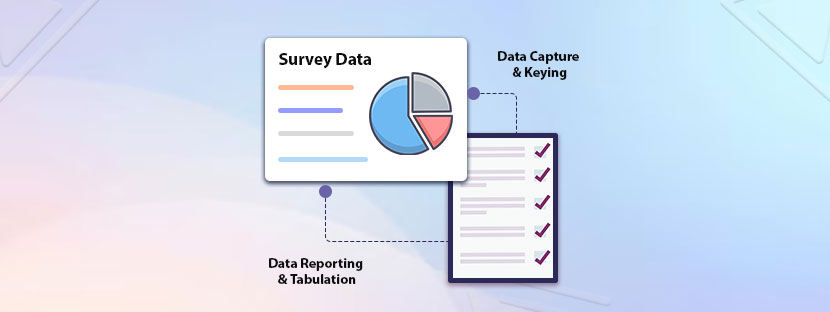In This Article
Do you want to collect feedback directly from your audience to serve them better? Well, for that, you need to survey and collect feedback from your target audience. However, conducting a survey may be an easy process but initiating the survey data entry is not. Businesses need to have proper knowledge regarding data entry and survey data recording.
But why do you need to conduct surveys? Generally, businesses get the real picture of how their customer feel about their products through surveys. Because businesses usually conduct surveys in an anonymous format. Due to its anonymous nature, customers or the targeted people feel free to share their opinions. Businesses collect these options to form future strategies for their work.
Do you know that only 8% to 10% of customers write feedback in the form of reviews? Therefore, the available reviews are not enough to make big business decisions. That’s why conducting surveys helps businesses to get more insights from the customers’ perspectives at a specific period. However, keeping the survey data in an accurate format is a must for further assessment.
Here, you’ll explore the best strategies of data entry for survey data along with its various steps in detail.
A. Understanding Survey Data Entry
As we know, recording the data in the designated place with accuracy is a part of the data entry process. Similarly, the data entry professionals will record the survey data in this procedure. Businesses usually prefer to have all processed data stored in the spreadsheet because it makes it easier for further assessments.
Surveys generally are the primary tool for collecting information directly from the customers. Assessing this information helps businesses frame competitive strategies and boost their operations. Sometimes businesses ask for suggestions in surveys, which businesses implement in their strategies for better growth.
Like any other data entry process, survey data entry as a procedure follows certain rules and regulations. Businesses sometimes face difficulties in managing survey records, and that’s why outsourcing is becoming popular nowadays.
B. Important Steps in Survey Data Processing
Surveys are vital for organizations, guiding long-term goals. Yet, entering and processing survey data eats up time. So, outsourcing these tasks lets businesses focus on essentials. Survey data processing involves four key steps, simplifying the entire procedure.
I. Survey Designing
Creating effective surveys is crucial for businesses aiming to enhance products and services, boosting future profits. The process of survey for data entry begins by closely collaborating with clients to grasp their business needs and comprehend the target audience.
Survey design comprises several steps, starting with setting clear objectives, defining the sample group, choosing the survey method, and ultimately crafting the questionnaire. The thoughtful construction of a survey questionnaire is key, as it yields valuable insights into the research topic, offering substantial benefits for business improvement.
By systematically aligning objectives, understanding the audience, and methodically constructing questions, organizations can gather pertinent data to refine their offerings and ultimately increase profitability. This collaborative approach in survey data entry, involving clients in the process, ensures that the survey not only meets business needs. But also resonates effectively with the intended audience.
As businesses strive for growth and profitability, the design and implementation of surveys play a pivotal role in steering them towards informed decisions and successful outcomes.
II. Data Capture and Keying
Data capture involves transforming information from paper or web-based questionnaires into electronic format. This method demands a mix of professional skills and up-to-date technology to gather important details from diverse surveys. Nowadays, Optical Character Recognition (OCR) and scanning techniques play a significant role in survey form scanning, significantly minimizing data entry mistakes.
The gathered data is then organized into suitable digital formats such as MS Excel, SAS, SPSS, MSWord, MySQL, etc. This modern approach to survey data entry not only streamlines the process but also enhances survey data accuracy and efficiency. Nowadays, businesses prefer to outsource survey data entry services to better manage their survey data.
III. Quality Improvement and Analysis
The main aim of survey data processing is to provide organizations with quality data for analysis. Survey form data is often prone to different types of errors in survey, omissions, and inconsistencies. These issues, if not fixed promptly, can complicate analysis and lead to incorrect conclusions. To prevent this, survey data entry service providers need a robust quality assurance framework. Ensuring data quality involves following a reliable methodology:
Firstly, survey forms are categorized based on defined criteria. Code structures are examined, and open-ended responses are standardized and recorded.
After data entry, all questionnaires are checked to ensure accurate completion of all data fields. A double keying process is employed to avoid discrepancies in data entry. Data is scrutinized for inconsistencies, and issues like missing, duplicate, or incomplete data are addressed.
By systematically applying these steps, service providers enhance the accuracy and reliability of survey data. This methodical approach ensures that the data is of high quality, facilitating precise and meaningful analysis for organizations. Adopting proven methodologies in the quality assurance process becomes essential for delivering dependable survey data. Also, safeguarding against sources of error in survey research, and ensuring that organizations can trust the results for informed decision-making.
IV. Data Reporting and Tabulation
Raw survey for data entry may only make sense to organizations once it’s presented in an easy-to-understand way. Extensive reporting and statistics are necessary for businesses to analyze situations and take appropriate actions through survey data entry. Reports vary based on organization needs, including quality reports, cross-tabulations, and frequency analyses. Survey reports offer a broad overview of responses.
In essence, survey data processing is a thorough and time-consuming task, demanding significant effort and accuracy. Nowadays, organizations can choose to outsource survey data processing services to professionals. These experts deliver quality services, following strict quality norms, and ensuring the confidentiality of crucial business information. This option allows organizations to efficiently handle and analyze survey data for well-informed decision-making.
C. Challenges Associated with Survey Data Entry
Data entry, in general, encounters significant challenges that stem from the intricate nature of coding complex question types. In the survey, you can also encounter some inherent ambiguity in respondents’ answers. One common issue arises when participants opt for more than one option instead of adhering to the instruction to select only one. This tendency can lead to confusion and misinterpretation of data during the entry process.
Another challenge emerges when respondents skip questions or entire sections, resulting in incomplete datasets that hinder the comprehensive analysis of survey results. Customers’ behaviors during surveys contribute further to the complexities. Participants often include comments alongside their answers. Hence, it will be like introducing an additional layer of complexity to the survey data entry process.
Moreover, some individuals create entirely new responses, circling them instead of selecting from the provided options. These unpredictable actions pose challenges for accurate data entry and increase the likelihood of different types of errors in survey in the recorded survey responses.
To mitigate these challenges, organizations need to implement strategies that simplify survey structures, provide clear and concise instructions, and employ user-friendly formats. These straightforward measures can enhance the survey data accuracy, ensuring more reliable and meaningful results for subsequent analysis. By addressing these challenges proactively, organizations can extract valuable insights from survey data, facilitating informed decision-making and strategic planning.
D. Best Practices to Eliminate Challenges
Ensuring accurate and efficient survey data entry requires careful consideration and systematic steps. Begin by thoroughly reviewing the survey questions and examining the provided options. This initial scrutiny is crucial to identify any potential issues or ambiguities in the questions and responses.
I. Create a Comprehensive Code Book
To simplify the analysis of responses, it’s beneficial to create a comprehensive code book. Assign a unique number to each response and use these numbers instead of words during data entry. Consistency is key, so stick to the same coding system for every question. This uniform approach makes it easier to familiarize yourself with the response values and streamlines the data entry process.
II. Adding an Identification (ID) Column
In cases where responses are unclear or left blank, establish a specific code and consistently apply it. This coding helps maintain consistency and highlights areas that may need further attention or clarification. Prior to commencing survey data entry, consider adding an identification (ID) column to the spreadsheet. Fill this column with unique ID numbers corresponding to each survey. Writing these ID numbers directly on the surveys facilitates error tracking during quality checks, enabling easy identification and correction of mistakes.
III. Follow Numbering Schemes
Adhering to a numbering scheme already present on the survey for data entry is advisable. This avoids the need for re-numbering responses, saving time and minimizing the risk of errors. Additionally, incorporating a copy of the codebook into the data entry spreadsheet enhances convenience and serves as a quick reference during the process.
IV. Maintain Clarity
For questions with multiple parts, use lowercase letters to label each part of the question. This simple practice aids in maintaining clarity and organization throughout the data entry process. In situations where respondents can check all applicable options, mark responses as “checked” or “not checked” with corresponding values of “1” and “0” in spreadsheets. This straightforward approach helps capture and categorize responses accurately.
V. Coding Properly
When dealing with responses involving more than one answer, coding them as “unclear” is preferable over making assumptions. This approach to survey data entry acknowledges the uncertainty and prevents inaccuracies in data representation. Similarly, for responses where the respondent creates their own answer, coding it as “unclear” or randomly selecting one of the provided answers ensures transparency and integrity in the data entry process.
VI. Make it in a Round Figure
In instances where respondents provide values higher than the given options, opt for the next closest 100-point response to maintain coherence. This thoughtful approach accounts for potential discrepancies in respondent-provided values.
VII. Re-check and Assure
Once data entry is complete, conduct a thorough re-check to ensure accuracy. Verify that the entered data aligns with the corresponding questions and ID numbers, reducing the likelihood of sources of error in survey research. This meticulous review is a critical step to guarantee the reliability and integrity of the survey data.
In essence, adopting a systematic and consistent approach to survey data entry, incorporating clear coding systems, and maintaining careful checks throughout the process are essential practices for obtaining accurate and reliable survey results.
Hence, these simple yet effective strategies contribute to the overall quality of data, empowering organizations to draw meaningful insights and make informed decisions based on the survey findings. Outsourcing companies follow all the practices to ensure the complete accuracy of the survey data recording process.











